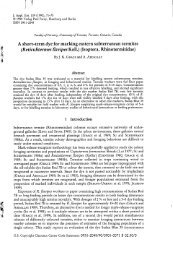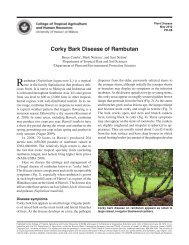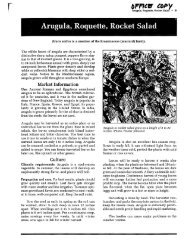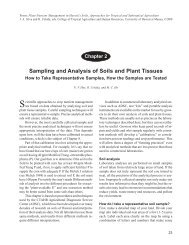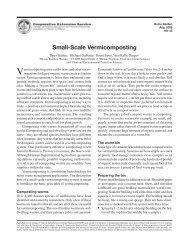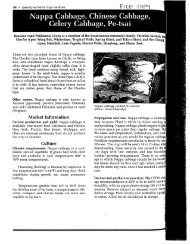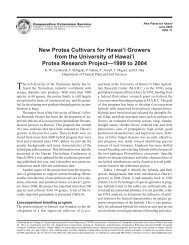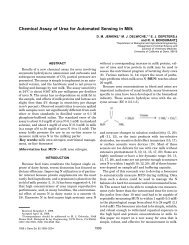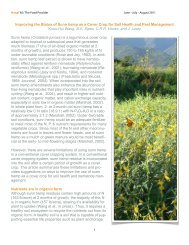Macadamia Nuts in Hawaii: History and Production - ctahr ...
Macadamia Nuts in Hawaii: History and Production - ctahr ...
Macadamia Nuts in Hawaii: History and Production - ctahr ...
Create successful ePaper yourself
Turn your PDF publications into a flip-book with our unique Google optimized e-Paper software.
Figure 84. Leaf stripper show<strong>in</strong>g the counter-rotat<strong>in</strong>g scrolls to separate the nuts from the leaves.<br />
pebbles. On lava l<strong>and</strong> this method created cavities<br />
throughout the harvest areas. To compound the<br />
problem, the pebbles <strong>and</strong> f<strong>in</strong>es that were picked<br />
up <strong>and</strong> dropped from the mach<strong>in</strong>e <strong>in</strong> mounds<br />
needed to be placed under the trees aga<strong>in</strong>. Considerable<br />
work on vacuum harvest<strong>in</strong>g needs to be<br />
done before this method can be used on macadamia<br />
nuts.<br />
Net harvest<strong>in</strong>g (Fig. 83) has been tried <strong>in</strong> orchards<br />
where the terra<strong>in</strong> was too difficult <strong>and</strong><br />
costly to improve to permit sweep harvest<strong>in</strong>g (59).<br />
In this method Yl-<strong>in</strong>ch polypropylene net was<br />
stretch-suspended on wires nailed to limbs of trees<br />
<strong>in</strong> a "V" design under the total canopy of trees. At<br />
gather<strong>in</strong>g time, the flaps at the bottom of the "V"<br />
were opened, <strong>and</strong> the nuts, leaves, <strong>and</strong> small twigs<br />
were dropped on polyethylene sheet<strong>in</strong>g to be lifted<br />
onto a leaf stripper (Fig. 84). The nuts were then<br />
dumped <strong>in</strong>to a trailer b<strong>in</strong> to be hauled to the<br />
husk<strong>in</strong>g station. This system of harvest<strong>in</strong>g was<br />
ab<strong>and</strong>oned because of the high <strong>in</strong>itial cost of<br />
nett<strong>in</strong>g <strong>and</strong> the high cost of ma<strong>in</strong>ta<strong>in</strong><strong>in</strong>g the nets<br />
damaged by large-branch breakage.<br />
Husk<strong>in</strong>g<br />
The <strong>in</strong>-husk harvested nuts are transported to a<br />
husk<strong>in</strong>g station by various means. Small farmers<br />
usually use bags for storage <strong>and</strong> haul<strong>in</strong>g; large<br />
growers use bottom-dump trailers (Fig. 85). The<br />
fleshy husk on the nuts as received from the fields<br />
needs to be stripped <strong>and</strong> removed as soon as pas-<br />
sible to m<strong>in</strong>imize loss <strong>in</strong> nut quality. Husk<strong>in</strong>g is<br />
usually done at a centralized station. The accumulated<br />
loose husks are then disposed of by whatever<br />
manner the grower chooses. They can be used for<br />
compost<strong>in</strong>g <strong>in</strong> nursery operations or as an organic<br />
material source for anthurium culture.<br />
The pr<strong>in</strong>ciples <strong>and</strong> methods of husk<strong>in</strong>g currently<br />
used were developed <strong>in</strong> earlier years when<br />
the economic potential of the macadamia nut was<br />
first recognized. The first attempt, obviously, was<br />
by h<strong>and</strong>; this evolved <strong>in</strong>to a crude system of us<strong>in</strong>g<br />
a rubber-tire-section doormat to hold the nuts<br />
steady <strong>and</strong> a hammer to break <strong>and</strong> tear the husk.<br />
The next <strong>in</strong>novation was the use ofa sp<strong>in</strong>n<strong>in</strong>g rear<br />
tire of a jacked-up car formfitted <strong>in</strong>to a metal<br />
abrad<strong>in</strong>g plate (Fig. 86). In this method, the nuts<br />
were dropped <strong>in</strong>to the trough created by the<br />
abrad<strong>in</strong>g plate <strong>and</strong> the sp<strong>in</strong>n<strong>in</strong>g tire, <strong>and</strong> husked<br />
by the forces thus created-much ak<strong>in</strong> to pebbles<br />
be<strong>in</strong>g strewn off the road by a rapidly turn<strong>in</strong>g tire<br />
on a car. With the cont<strong>in</strong>ued growth of the <strong>in</strong>dustry,<br />
the jacked-up-tire husker was further improved<br />
as a permanent stationary system us<strong>in</strong>g<br />
electricity. One small grower still uses this system<br />
<strong>and</strong> has used the same tire for the last 25 years (Fig.<br />
87). Another husker now popular is based on<br />
counter-rotat<strong>in</strong>g scrolls (Fig. 88). Although this<br />
method has been patented, the true credit for its<br />
<strong>in</strong>vention is obscure.<br />
A new husk<strong>in</strong>g mach<strong>in</strong>e (Fig. 89) has been<br />
<strong>in</strong>vented by Quent<strong>in</strong> F. G<strong>and</strong>all of Hilo <strong>and</strong> is<br />
63



